Attached files
| file | filename |
|---|---|
| EX-99.1 - EX-99.1 - AMICUS THERAPEUTICS, INC. | a17-7414_1ex99d1.htm |
| 8-K - 8-K - AMICUS THERAPEUTICS, INC. | a17-7414_18k.htm |
Exhibit 99.2
FY16 Financial Results Conference Call & Webcast March 1, 2017
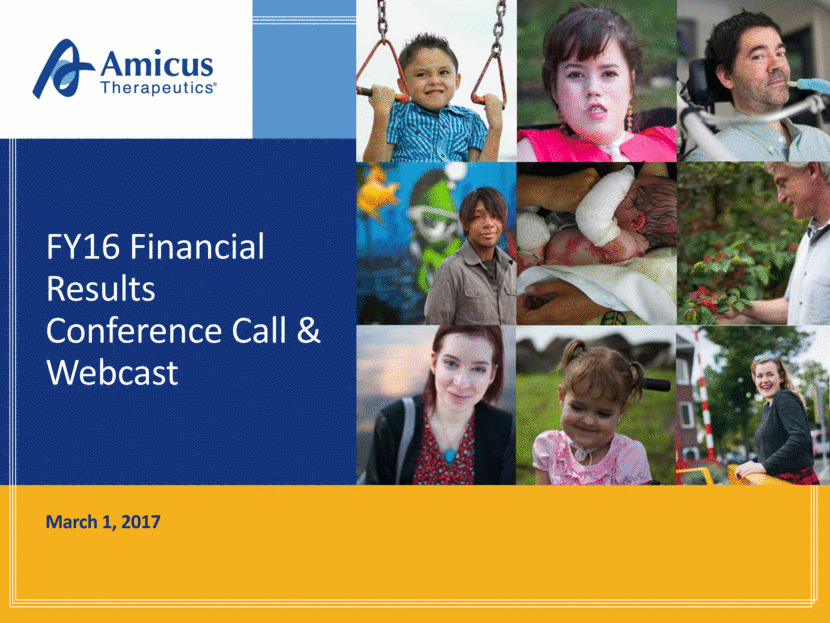
Safe Harbor This presentation contains "forward-looking statements" within the meaning of the Private Securities Litigation Reform Act of 1995 relating to preclinical and clinical development of our product candidates, the timing and reporting of results from preclinical studies and clinical trials, the prospects and timing of the potential regulatory approval of our product candidates, commercialization plans, financing plans, and the projected cash position for the Company. In particular, this presentation relates to the preliminary data from a global Phase 1/2 study (ATB200-02) to investigate ATB200/AT2221. The inclusion of forward-looking statements arising from this preliminary data and study should not be regarded as a representation by us that any of our plans will be achieved. Any or all of the forward-looking statements in this presentation may turn out to be wrong and can be affected by inaccurate assumptions we might make or by known or unknown risks and uncertainties. For example, with respect to statements regarding the goals, progress, timing, and outcomes of discussions with regulatory authorities, and in particular the potential goals, progress, timing, and results of preclinical studies and clinical trials, actual results may differ materially from those set forth in this release due to the risks and uncertainties inherent in our business, including, without limitation: the potential that results of clinical or preclinical studies indicate that the product candidates are unsafe or ineffective; the potential that it may be difficult to enroll patients in our clinical trials; the potential that regulatory authorities, including the FDA, EMA, and PMDA, may not grant or may delay approval for our product candidates; the potential that we may not be successful in commercializing Galafold in Europe or our other product candidates if and when approved; the potential that preclinical and clinical studies could be delayed because we identify serious side effects or other safety issues; and the potential that we will need additional funding to complete all of our studies. Further, the results of earlier preclinical studies and/or clinical trials may not be predictive of future results for any of our product candidates. The preliminary data and Phase 1/2 study discussed herein is inherently preliminary and early in the study, derived from a limited patient set, and later trial results with this patient set or others may not be consistent with these preliminary results. With respect to statements regarding projections of our cash position, actual results may differ based on market factors and our ability to execute operational and budget plans. In addition, all forward-looking statements are subject to other risks detailed in our previous filings with the SEC and in our Annual Report on Form 10-K for the year ended December 31, 2016 to be filed later today. You are cautioned not to place undue reliance on these forward-looking statements, which speak only as of the date hereof. All forward-looking statements are qualified in their entirety by this cautionary statement, and we undertake no obligation to revise or update this presentation to reflect events or circumstances after the date hereof. Introduction
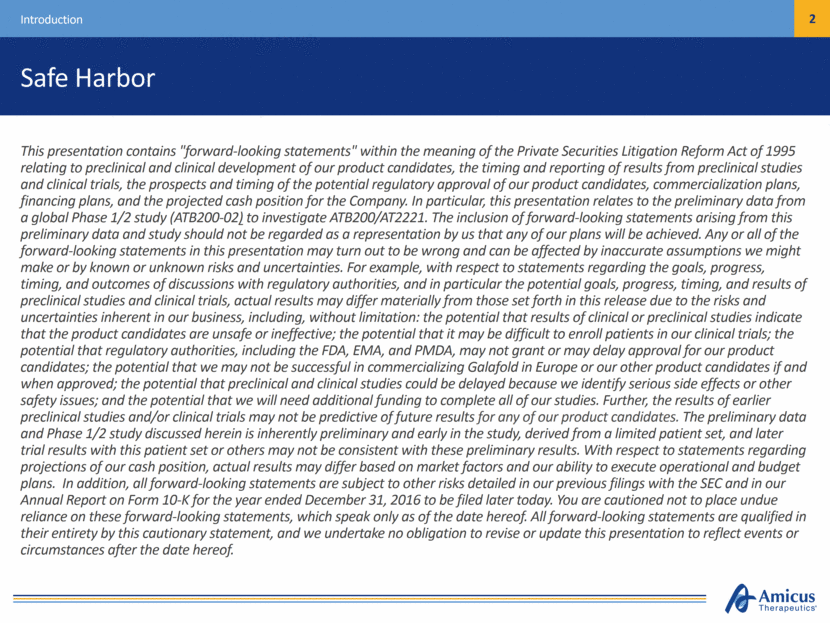
Introduction

Pompe Phase 1/2 data cascade Pompe end of Phase 2 meeting Runway into 2H18 Meaningful revenue contribution from Galafold EB Phase 3 data Galafold international launch continues Japan NDA submission Fabry GI study initiation 2016 Key Accomplishments in 2016 Introduction Positive preliminary data in Phase 1/2 study in Pompe patients $330M in cash (12/31/16) Phase 3 enrollment near complete EU approval International launch success Regulatory progress Pompe Disease (ATB200/AT2221) Strong Balance Sheet Epidermolysis Bullosa (EB) (SD-101) Fabry Disease (Galafold™)
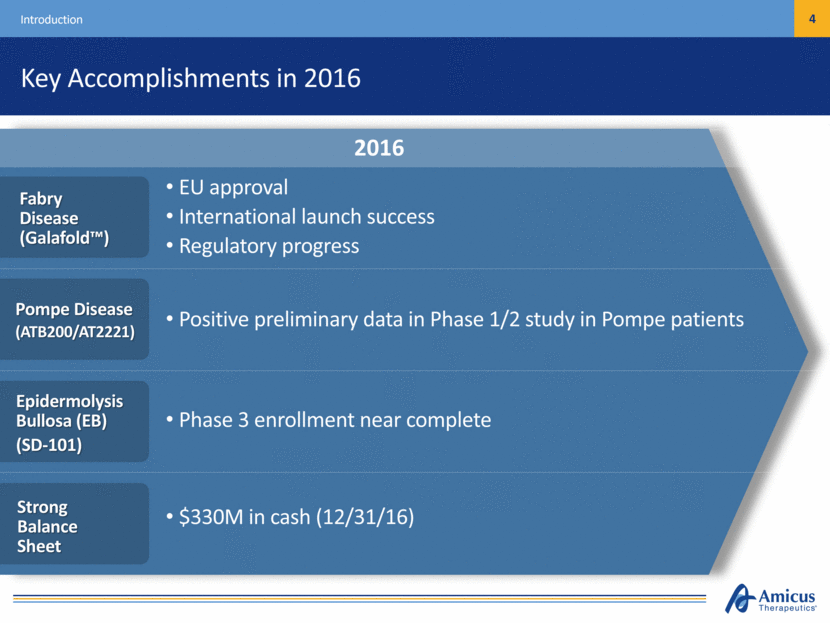
2017 Key Strategic Priorities Introduction We Remain Sharply Focused on FIVE Key Strategic Priorities as We Continue to Build a Top Global Biotechnology Company Focused on Rare Devastating Diseases Advance International Galafold Launch Submit Japanese New Drug Application (J-NDA) for Migalastat Establish Definitive Proof of Concept for ATB200/AT2221 with Clear Path to Registration for Pompe Disease Successfully Complete Phase 3 EB Study Maintain Financial Strength
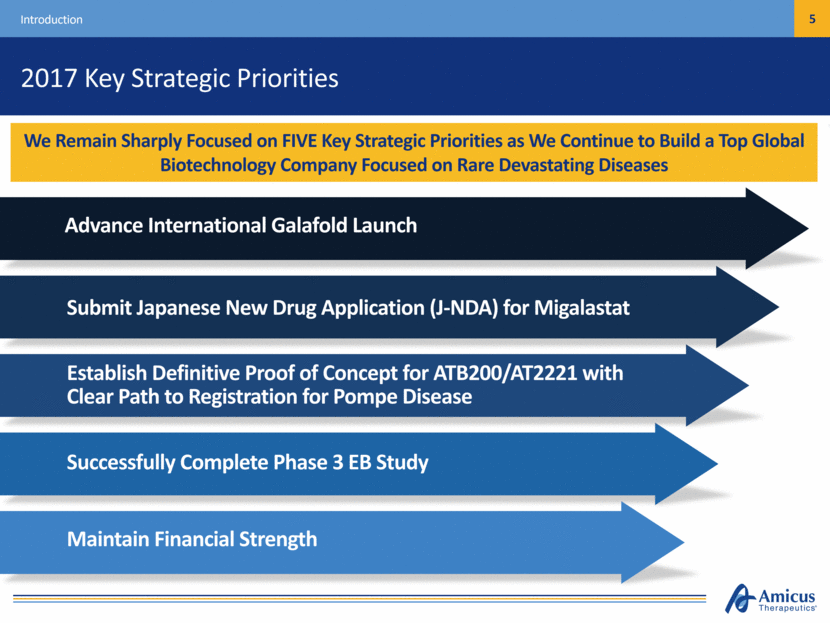
Galafold™ (Migalastat) Precision Medicine for Fabry Disease Continue Launch Execution and Geographic Expansion

Early Success with International Launch (as of 2/28/17) Initial Launch Success Driven by Germany with ERT-Switch & Naïve Patients, Reimbursement Now Available in 10 Countries* Galafold: Precision Medicine for Fabry Disease Patients (Switch & Naïve) on reimbursed Galafold (2/28/17) 75 Countries with pricing discussions ongoing 14 Countries with available reimbursement* 10 Countries with Amicus footprint 27 *Commercial and Expanded Access Programs (EAPs) Target Number of Patients on Reimbursed Galafold by YE17 300
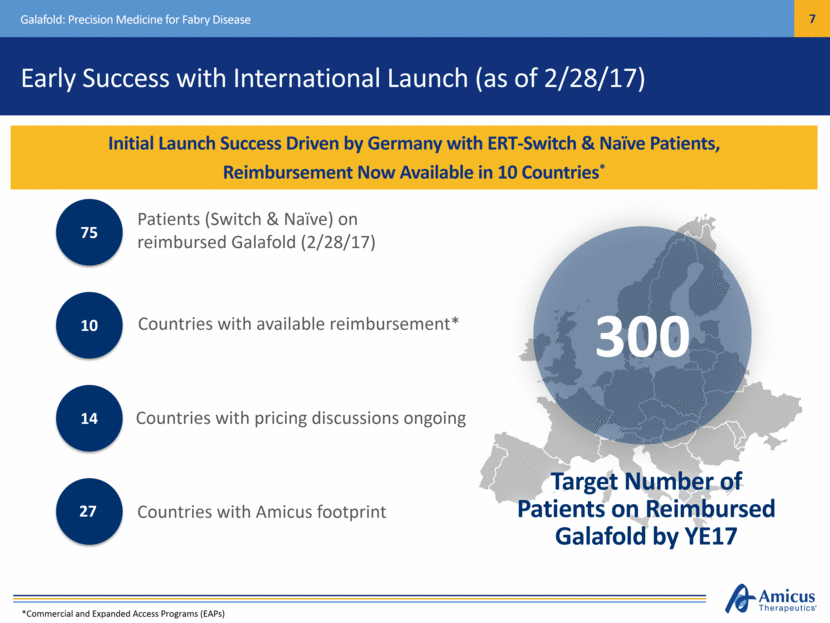
German Launch Update (as of 2/28/17) Galafold: Precision Medicine for Fabry Disease Germany is an Important Indicator for EU Launch Success *Market share assumptions based on estimated number of ERT-treated patients with amenable mutations in Germany as of May 2016 IMPORTANT EARLY INDICATORS IN GERMANY Vast majority switch patients ~33% of eligible switch patients now on Galafold* All newly experienced patients & physicians Majority of switches from Replagal™ Male / female mix 16 unique prescribers Galafold ~33% ERT ~67% Current Approximate Market Share*
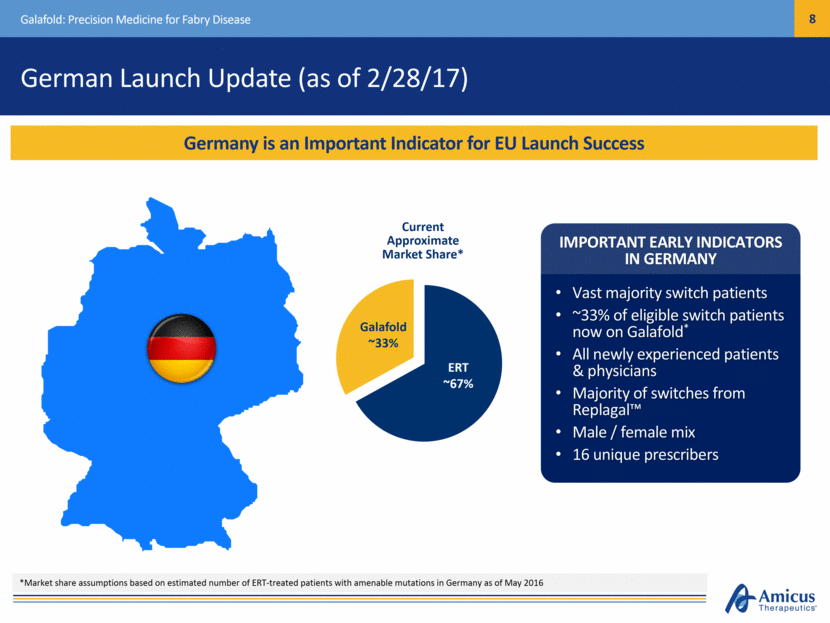
Global Regulatory Strategy to Reach More Patients Galafold: Precision Medicine for Fabry Disease EU Approval and Launch (May 30, 2016) Active Expanded Access Programs (EAP) in 3 Territories with More Initiated EU Approval is Gateway to ~75% of Global ERT Market 6 Additional Regulatory Submissions Complete, Process Initiated in Other Key Geographies U.S. Full Approval Pathway Defined by Amicus Japanese NDA Targeted 1H17 1 Additional Approval (Switzerland)
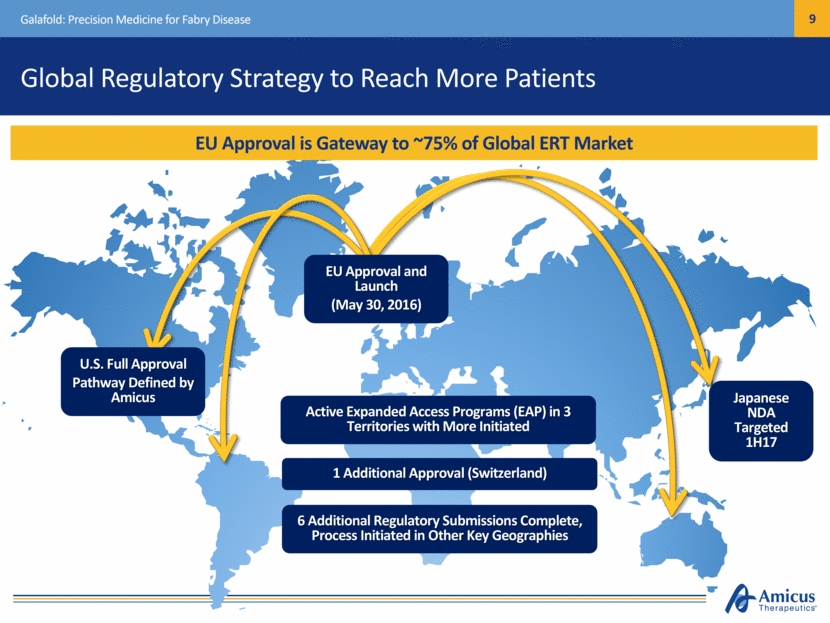
ATB200 Novel ERT for Pompe Disease Establishing Human Proof of Concept and Validating Biologics Platform in 2017
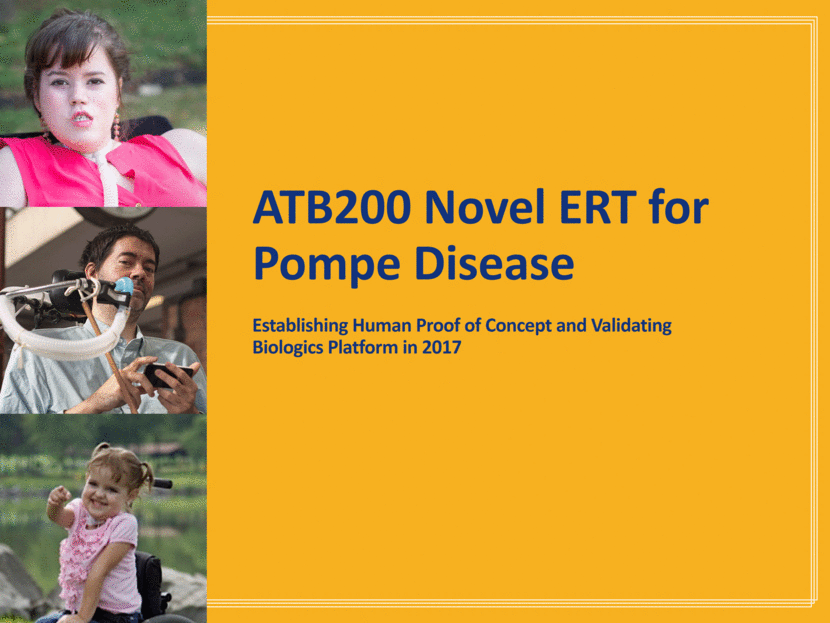
Novel Pompe Treatment Paradigm with Three Key Differentiators Novel ERT for Pompe Disease – ATB200 + Chaperone Chaperone addition Optimized mixture of glycans ATB200 + Chaperone: A Highly Differentiated Approach ATB200 (Novel ERT) High levels of M6P and bis M6P *Artist rendering, not actual product image

Pompe Disease: A Complex Disease with Significant Unmet Needs We’ve Made Great Strides and Expect to Address Key Remaining Questions in 2017 Novel ERT for Pompe Disease – ATB200 + Chaperone preclinical clinical Enhanced levels of M6P Optimized glycosylation Improved in vitro cellular uptake Enhanced ERT activity & stability Greater ERT uptake into muscle in Pompe KO mice Greater glycogen reduction in Pompe KO mice Desired PK profile & half-life Safety in ERT-switch Early biomarkers of muscle repair Excellent tolerability Muscle disease-causing biology Improved clinical outcomes? Superior functional outcomes vs SOC in Pompe KO mouse key question "The scientific findings and preclinical data are profound and shed new light on questions about the underlying cause of muscle damage and weakness in Pompe patients. Furthermore, these results provide a window into a potential underlying link among key muscular dystrophies, such as Pompe, Limb Girdle, and Duchenne. Amicus has been a pioneer in advancing the scientific understanding of Pompe disease and in developing next-generation therapies for patients.“ Grace K. Pavlath, Ph.D., Senior Vice President, Scientific Program Director of Muscular Dystrophy Association
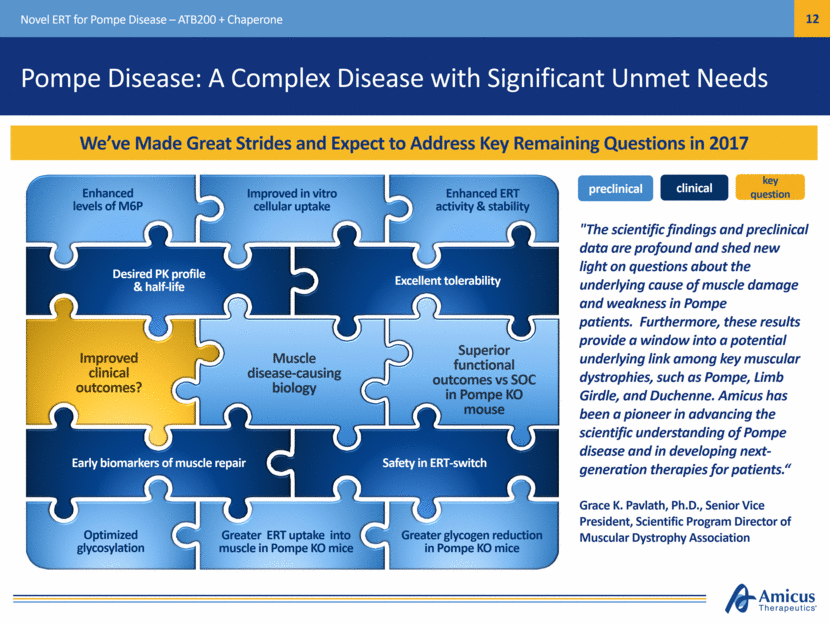
Preliminary Clinical Data Summary Safety (N=13)* No serious adverse events (SAEs) AEs were generally mild and transient Tolerability No infusion-associated reactions following 150+ infusions in all patients enrolled to date PK (N=10)** Clinical PK profile as predicted consistent with previously reported preclinical data Biomarkers of muscle damage (CK, AST, ALT) and substrate (urine Hex4) (N=10)** Decrease or normalization of muscle injury biomarkers in a majority of patients Decreases in urine Hex4 in all patients Improvement in all biomarkers suggests positive effect of ATB200/AT2221 on muscle cells Pompe Phase 1/2 Study ATB200-02 Preliminary Data ATB200/AT2221 Demonstrates Promising Preliminary Results in Initial ERT-Switch and Naïve Patients at the Targeted Therapeutics Dose *N=10 from Cohort 1 (Ambulatory ERT-Switch); N=1 from Cohort 2 (Non-Ambulatory ERT-Switch); N=2 from Cohort 3 (Naïve) **N=8 from Cohort 1 & N=2 from Cohort 3
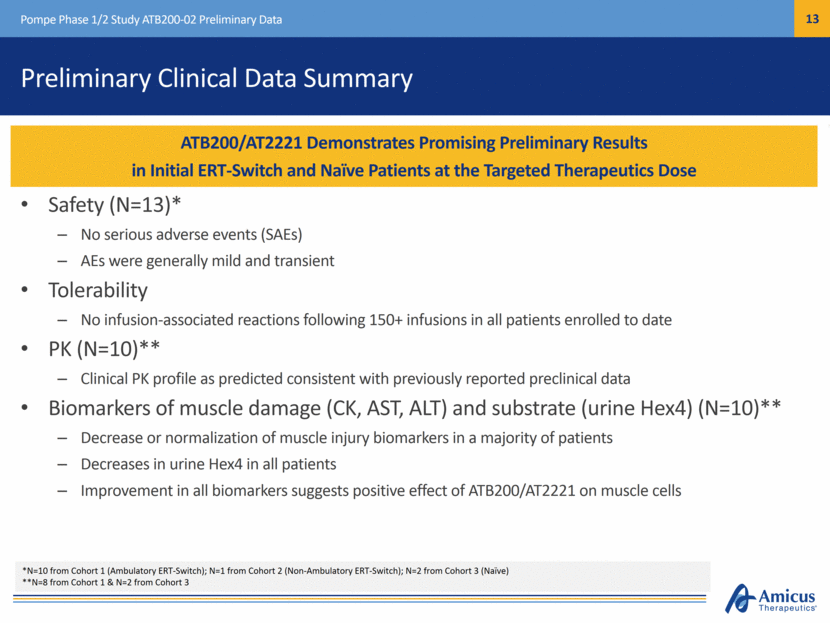
Pompe Clinical Study ATB200-02 Data Cascade Novel ERT for Pompe Disease – ATB200 + Chaperone Target Enrollment Achieved with a Cascade of Additional Data Points During 2Q17 and 3Q17 to Demonstrate Proof of Concept Pompe Milestones in 2017 Meeting with U.S. and EU regulators 18-WEEK DATA Safety / tolerability Pharmacokinetics (PK) EXTENSION DATA Motor/pulmonary function Additional extension study data (all Cohorts) Data in ERT-naïve patients (Cohort 3) Data in non-ambulatory ERT-switch patients (Cohort 2) Additional data & initial extension data in Cohort 1 Biomarkers Immunogenicity
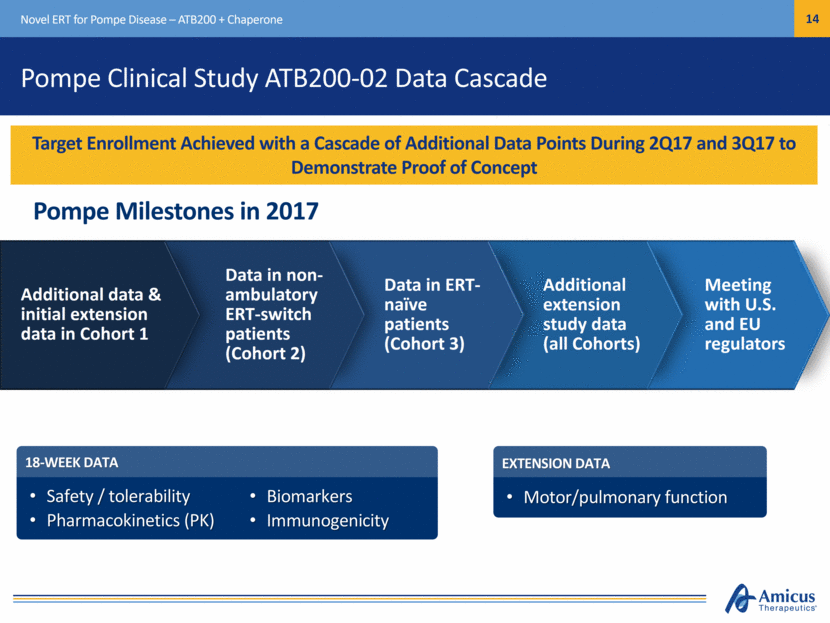
SD-101 for Epidermolysis Bullosa Potential First-in-Class Treatment with Phase 3 Data Anticipated Mid-2017
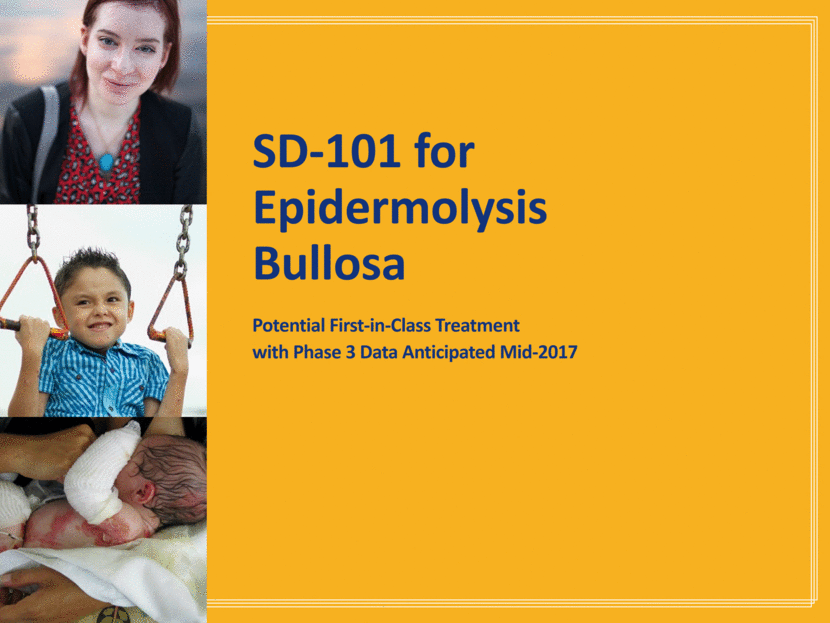
Phase 3 Study - Delivering on Our EB Vision Phase 3 Study Optimized for Success with Top-Line Data On Track for Mid-2017 SD-101 for EB SD-005 Study Design Optimized 95%+ participation in extension study Enrollment near complete Top-line data anticipated mid-2017 Status Sample size of up to 150 patients Larger baseline target wound size Time to wound closure endpoint elevated
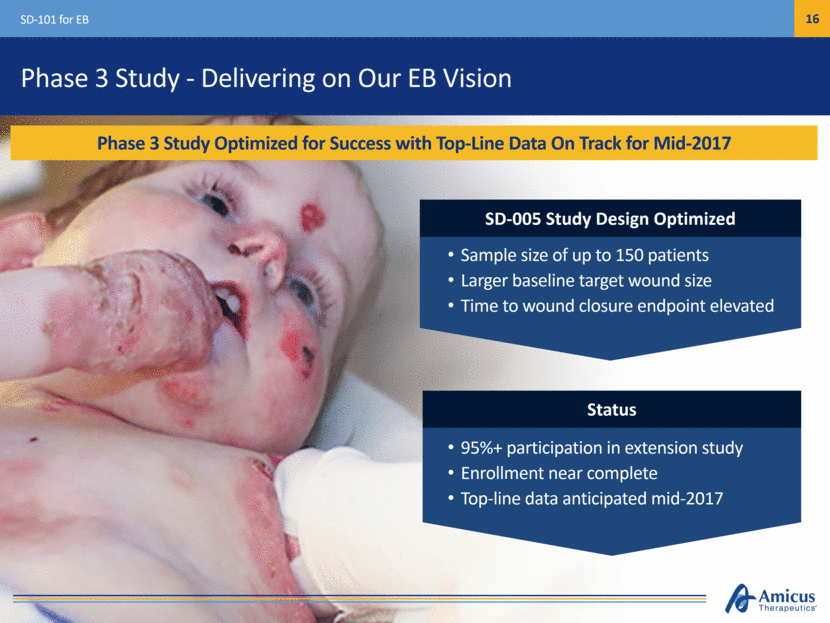
Financial Summary

FY16 Select Financial Results Financial Summary December 31, 2016 December 31, 2015 Product revenue $5.0M - R&D Expense $104.8M $76.9M G&A Expense $71.2M $47.3M Net Loss ($200.0M) ($132.1M) Net Loss Per Share (1.49) (1.20) First-Ever Year to Report Product Revenue of $5M from Sales of Galafold
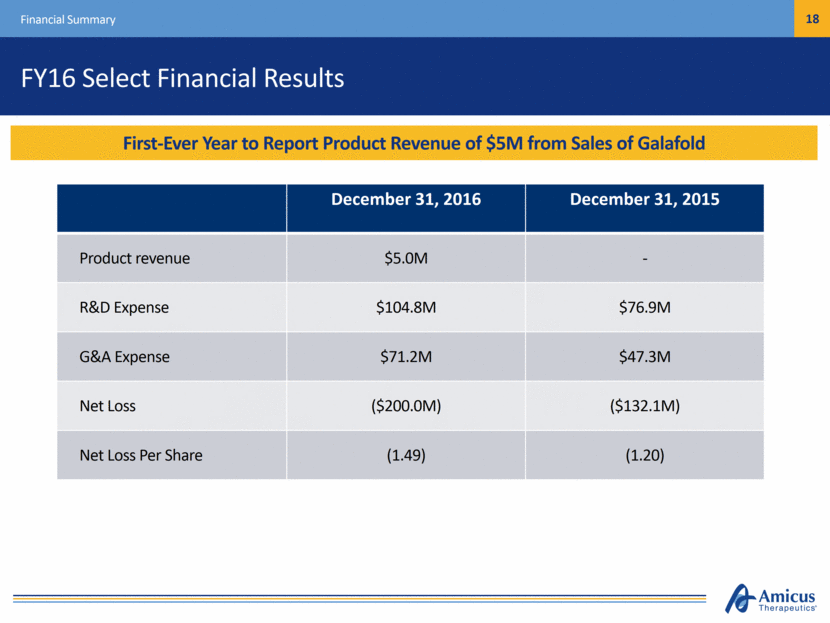
Financial Summary & Guidance Conclusion Financial Position December 31, 2016 Cash $330M Debt $250M FY17 Net Operating Cash Flow Guidance $175-$200M FY17 Net Cash Spend Guidance* $200-$225M Cash Runway 2H18 Capitalization December 31, 2016 Shares Outstanding 142,691,986 Cash Position Provides Runway Under Current Operating Plan into mid-2017 Balance Sheet Strengthened with $330M Cash at 12/31/16 and Cash Runway Into 2H18 *Includes third party milestone payments and capital expenditures
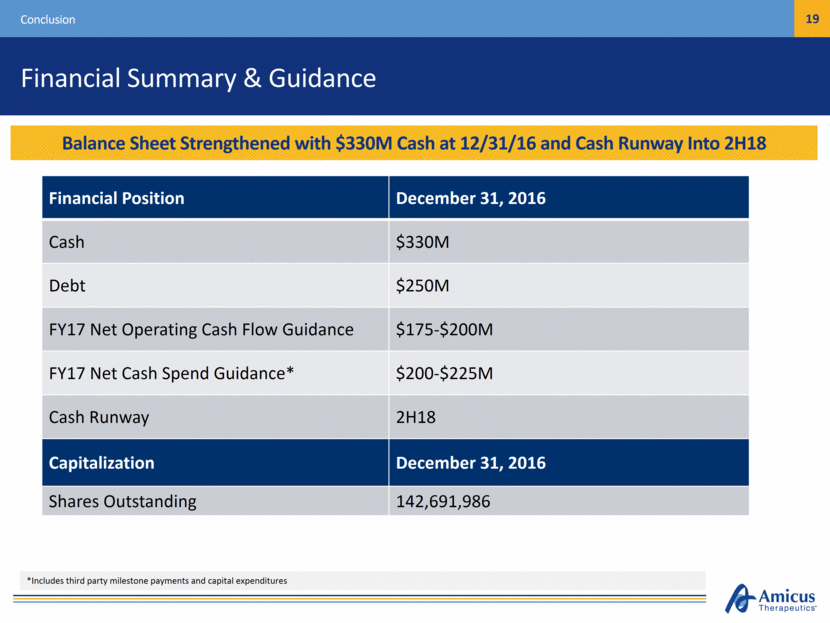
Closing Remarks
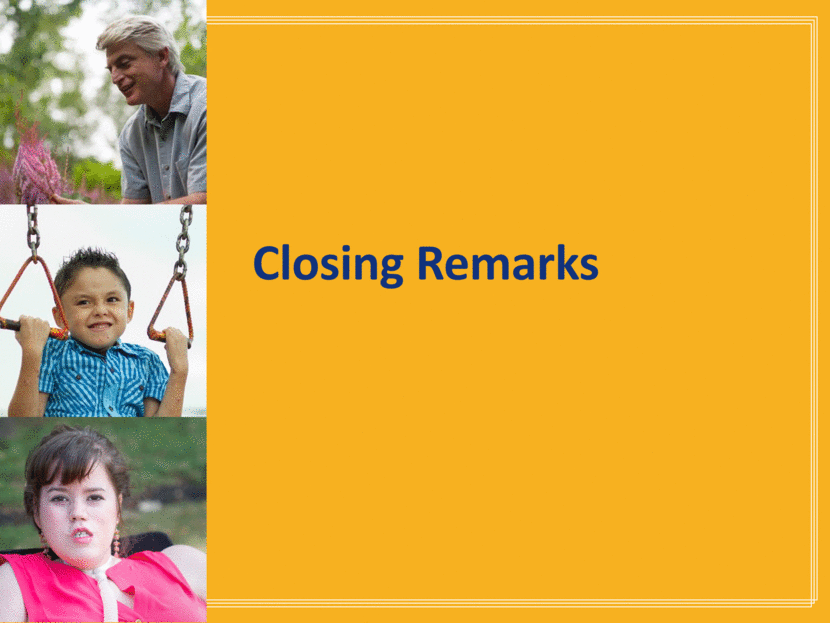
Pompe Phase 1/2 data cascade Pompe end of Phase 2 meeting Runway into 2H18 Meaningful revenue contribution from Galafold EB Phase 3 data Galafold international launch continues Japan NDA submission Fabry GI study initiation 2017 Key Anticipated Milestones in 2017 Conclusion Phase 1/2 data cascade in 2Q and 3Q Meetings with U.S. and EU regulators Significant revenue contribution Cash runway into 2H18 Phase 3 top-line data mid-2017 300 patients on reimbursed Galafold by YE17* Japan NDA submission in 1H17 Fabry GI study Pompe Disease (ATB200/AT2221) Strong Balance Sheet Epidermolysis Bullosa (EB) (SD-101) Fabry Disease (Galafold) *Commercial and Expanded Access Programs (EAPs)
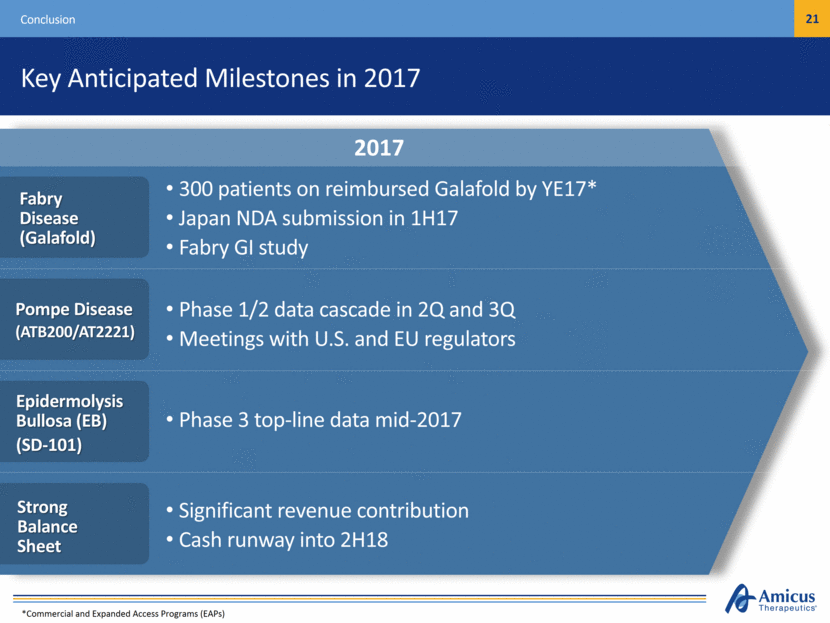
Our Vision – Maximizing Impact on Patients to Drive Shareholder Value Conclusion 2010 2014 2018 YE16 2023 ~5,000 Patients* ~800 Patients* ~250 Patients* ~90 Patients ~37 Patients The Ultimate Measure of Our Success Will be the Number of Patients with Devastating Rare Diseases Treated with an Amicus Product = 20 patients *Clinical & Commercial 22
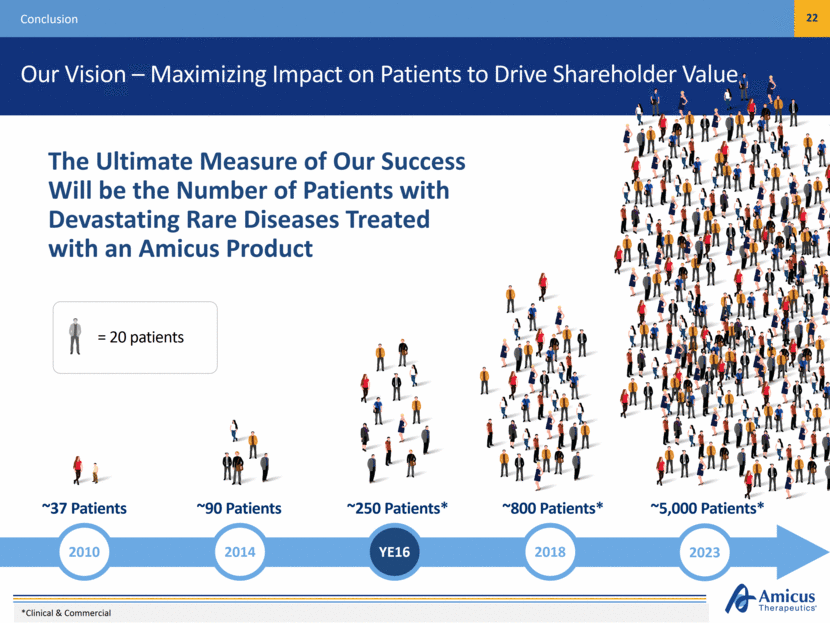
Thank You

